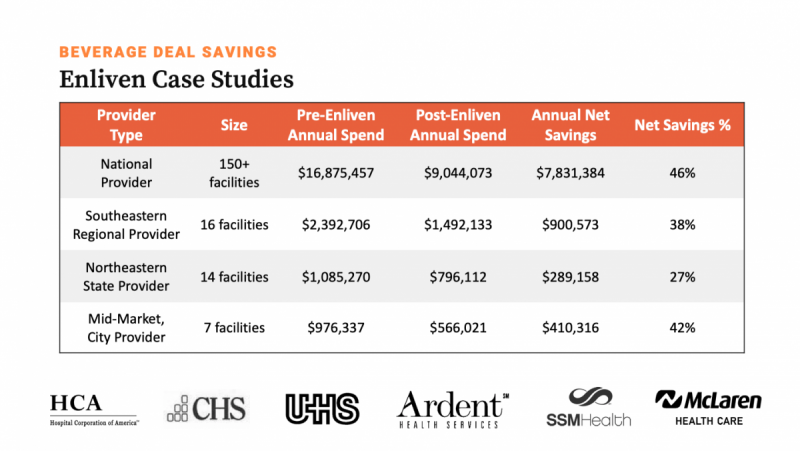It’s November. You have probably already settled on your primary strategies for achieving significant cost savings in 2019.
But, like any savvy supply chain exec or CFO, you know that you need a cushion, a back-stop, a sure-thing, sure-fire way to still hit your 2019 savings target when the inevitable road block appears with Plan A.
A beverage deal can provide that financial cushion you’re looking for. They’re now a proven best practice among all the leading hospital operators. They generate significant savings. And you can hire experts in this niche to deliver the savings on your beverage spend with a no-risk, no-cost, performance-based compensation model.
Outsourcing your beverage deal work to known experts means that, in 2019, you and your team can focus on the much more difficult job of reducing costs associated with physician preference items.
What is a “Beverage Deal”?
“Beverage deal” is a more colloquial term for a Pouring Rights Agreement, or PRA. It simply means that your organization agrees to buy, sell and distribute only one beverage company’s portfolio of products at your facilities. Every college and university in America has a beverage deal with either Coca-Cola or Pepsi. So does every theme park, arena, stadium, casino, restaurant chain, hotel chain and airline.
Hospital beverage deals usually include all channels of beverage distribution on campus–cafeterias, patient feeding, catering and vending. And they include all types of beverages that are packaged in bottles and cans or dispensed with a fountain drink machine: waters, teas, juices, sports drinks and soft drinks. Brewed coffee and brewed tea are typically not included in such deals.
Your organization can have a beverage deal no matter which GPO you use or whether or not you outsource your food & beverage to a third party or do it all in-house. What matters most is that you have a direct partnership with one of the beverage companies, not one mediated by your GPO or cafeteria operator (if you have one).
For more information about how beverage deals work, you can download a two-page executive summary or watch our overview webinar.
How much can you expect to save?
If you negotiate a best-in-class beverage deal, you should save at least 20% off your current overall spend. In dollar terms, our most recent healthcare client (a hospital system with four facilities and approximately 1,200 licensed beds) will save more than $250,000 annually. That’s a true, net, bottom-line number, after our compensation.
Larger hospital operating companies can expect to generate much larger savings. The chart below shows case studies of recent beverage deal net savings achieved by Enliven for larger IDN clients.

How common are Beverage Deals in healthcare?
Approximately one third of all hospitals in the United States are currently operating under some kind of a beverage deal. Beverage deals are now a best practice among the largest and most sophisticated hospital companies.
One caveat: Don’t wait. Best-in-class deals take several months to execute.
If you think securing a beverage deal might make sense for your organization in 2019, it’s important to understand that it usually takes between six to ten months to secure a best-in-class deal.
The discovery work required to establish your current beverage volume, spend and mix usually takes four to six weeks. After that point, it will take another four to six months to issue the RFP to the beverage companies, fully engage both the local bottlers and the national corporate executives, negotiate best and final offers from all parties, pick a winner, finalize your contract, install all the new equipment and begin realizing savings from a beverage deal.
You should give yourself at least six months, start to finish. And it may very well take seven to ten months, depending on the size and complexity of your organization.
Why not?
Why risk not hitting your 2019 savings targets when you can improve your odds significantly by securing a beverage deal next year? We can estimate the savings that you can expect for your organization based on just a couple data points that you definitely have at your fingertips. Let’s talk.
Photo by Carlos Muza on Unsplash